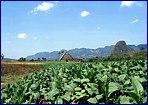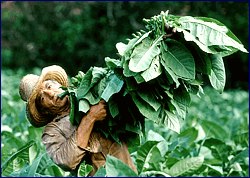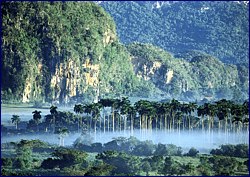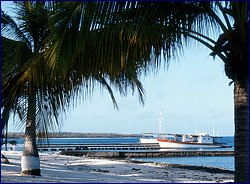 |
 |

THE BEST TOBACCO
If you’ve ever wondered where the world’s finest cigars start out, it’s in the lovingly cultivated tobacco plantations of Cuba’s Pinar del Rio province. But those plantations are only part of the area’s magic.
With its unusual mogotes (rounded limestone mountains) strung along flat plains, Pinar del Rio’s landscape rivals any inthe world. These plains, where Cuban cowboys roam and dreamy villages doze, are ringed by mountain ranges crowned by vast stretches of tropical forests.
Several highways criss-cross the area, through the mountains or along the coast, yielding spectacular views at every turn. The Central Highway winds through most of Pinar del Río's mountain ranges, and swings by Pan de Guajaibón—Cuba's highest western mountain peak.
A special local treat is Guayabita del Pinar, an exquisite guava liqueur unique to this area.

| Places to visit |
![]() Ancient ruins—French coffee plantation
Ancient ruins—French coffee plantation
The Buenavista estate in Las Terrazas has been restored, and is a lovely trip into history.
![]() Soroa
Soroa
The 22-metre-high, spring-fed Rainbow Waterfall brightens this spot. Soroa is also home to about 1,000 species of exotic orchids.
![]() Cueva de los Portales
Cueva de los Portales
 This was Che Guevara’s hideout during the 1962 Missile Crisis. Today, the cave houses a small museum.
This was Che Guevara’s hideout during the 1962 Missile Crisis. Today, the cave houses a small museum.
![]() Viñales Valley, Sierra de los Organos
Viñales Valley, Sierra de los Organos
A national monument, this valley was declared a UNESCO a World Cultural and Landscape Site in 1999. It is also home to a 270-million-year-old fossil, palma corcho (mycrocycas calocoma).
![]() Guach Palace, City of Pinar del Río
Guach Palace, City of Pinar del Río
This has been called the strangest building in Cuba. The palace, reminiscent of early 20th-century Catalonian modernism, houses the Museum of Natural Science.
![]() Gran Caverna de Santo Tomás
Gran Caverna de Santo Tomás
 One of the largest in the world, this cave tunnels down to 45 kilometres.
One of the largest in the world, this cave tunnels down to 45 kilometres.
![]() Cuban Mantua
Cuban Mantua
A small country village and national monument where in January, 1896, the Independence Army's western campaign came to an end. It may have been founded by survivors of an Italian shipwreck in the late 17th century.
![]() María la Gorda Beach
María la Gorda Beach
An international dive centre sits here at Cuba's westernmost point, on the hilly and pristine Guanahacabibes peninsula.
 18.24°C
18.24°C




